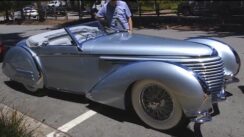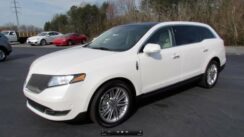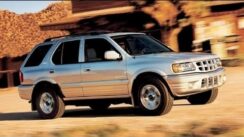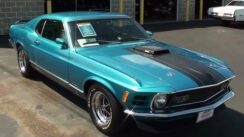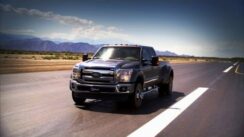VIDEO: Ford Mustang Shelby GT350R Tracked

Ford claims the Shelby GT350R Mustang is the “Most Track-Capable Production Mustang Ever”. Watch the GT350R around Mazda Raceway Laguna Seca and decide for yourself.
Ford Shelby GT350R Mustang is the latest track-ready masterpiece to emerge from the Ford Performance mantra of “innovation through performance.”
In 1965, Ford and Carroll Shelby developed a road-racing version of the popular Ford Mustang – the Shelby GT350 Competition model. Lighter, more powerful, and with a highly developed suspension, it is one of the most iconic racing Mustangs ever produced.
The Shelby GT350R has been designed and engineered in the same spirit, delivering never-before-seen track capability from a Mustang – thanks to innovations in aerodynamics, chassis engineering and light-weighting.
“The Shelby GT350R Mustang is a no-compromise car in the pursuit of maximum track capability,” said Raj Nair, Ford group vice president, Global Product Development. “It is a thoroughbred street car making use of technology and ingenuity to deliver performance few enthusiasts have ever experienced.”
Shelby GT350R features the first-ever production V8 from Ford with a flat-plane crankshaft – the most powerful naturally aspirated engine Ford has ever produced – plus a specially tuned suspension. It is fitted with revised spring rates and antiroll bars, lower ride height, unique track-tuned alignment settings, revised bushings and jounce bumpers, cross-axis ball joints in the front suspension, and revised calibration controlling the MagneRide dampers.
“The Shelby GT350R Mustang is a car with the nimbleness and power delivery you want on a road course,” said Nair. “This isn’t just about horsepower. The Shelby GT350R is an all-around balanced athlete – one that is extraordinarily precise and agile.”
Weight reduction in pursuit of performance
Shelby GT350R engineers delivered against aggressive targets for weight reduction. If a part did not make the car faster around a road course, it was considered for deletion.
Items removed include air conditioning, the stereo system, rear seats, trunk floorboard and carpet, backup camera and emergency tire sealer and inflator. Exhaust resonators also have been removed for weight savings with the benefit of creating a sharper exhaust tone.
Shelby GT350R is more than 120 pounds lighter than the Shelby GT350 Track Pack model, which has proven its durability in multiple 24-hour racetrack tests.
For customers seeking more comfort in their Shelby GT350R, Ford is offering an optional Electronics Package. Included is dual-zone air conditioning, 8-inch touch screen with navigation, seven-speaker audio system, turn signal mirrors and more.
Aggressive aerodynamics
Shelby GT350R has been optimized for aerodynamic excellence. Details including the hood vent for heat extraction and lift reduction, underbody belly pans front and rear, an aggressive diffuser, vented wheel wells and turbulence-reducing fender vents, wheel air curtains and side skirts all remain on Shelby GT350R, but the car’s downforce capability has been increased.
Revisions to the front splitter maximize downforce, while an all-new high-efficiency carbon fiber rear wing has been added in anticipation of competition. The wing moves the vehicle’s center of pressure rearward while improving downforce and lift balance – ideal for high-speed track work.
“Shelby GT350R’s highly efficient aerodynamics, innovative light-weighting and world-class chassis deliver a truly spectacular driving experience that makes you feel like a professional racing driver,” said Kerry Baldori, Ford Performance chief functional engineer.
World-class powertrain
The new 5.2-liter dual-overhead-cam V8 engine is the first-ever production V8 from Ford with a flat-plane crankshaft – an architecture typically found only in racing applications or exotic European sports cars.
Unlike traditional V8s, where the connecting rods are attached to the crankshaft at 90-degree intervals, this design evenly spaces all crank pins at 180-degree intervals to optimize high-speed engine breathing. It is the most powerful naturally aspirated production Ford engine ever, with 526 horsepower and 429 lb.-ft. of torque.
An air-to-oil engine oil cooler typically only found on race cars maintains engine temperatures under the most severe conditions, as does a standard cooler for the six-speed manual transmission.
A Ford-tuned limited-slip Torsen differential with 3.73 axle ratio is optimized for cornering grip and straight-line traction, while an electronically moderated rear-mounted air-to-oil differential cooler maintains ideal temperatures during track driving.
Dedicated R design details
Aside from carbon fiber wheels, larger front splitter and rear wing, Shelby GT350R includes distinct design details. Exterior touches include red painted brake calipers, red pin striping at the edges of the optional over-the-top racing stripes and Shelby GT350R badging. Inside is high-contrast red stitching, Shelby GT350R badging and the D-shaped steering wheel fitted with a red center mark at the top.
The Wheels
For the Shelby GT350R, Ford dreamed of using the ultimate high-performance carbon fiber material for its unique wheels.
But while the automotive aftermarket and a low-volume supercar manufacturer have offered carbon fiber wheels, Ford and Australian supplier Carbon Revolution took on the challenge of crafting the first mass-produced, track-capable carbon fiber wheels as standard equipment for the Shelby GT350R.
Designed, developed and tested with the highest of quality standards in mind, these first-of-a-kind wheels deliver unprecedented chassis performance, massive weight savings and improved driving dynamics.
In early testing with benchmark vehicles, prototype wheels showed significant potential – improving suspension response times, chassis dynamics, steering feel and ride quality. When the decision was made to pursue this technology for use in a production vehicle, the engineering team was challenged to develop a wheel that met Ford’s strict standards for durability, quality, craftsmanship and premium finish.
Why carbon fiber?
Among sports car enthusiasts, carbon fiber wheels are on the short list of dream components for high-performance vehicles. In the rarefied world of supercars, only a select few examples have left the factory wearing carbon fiber wheels, namely, the Koenigsegg Agera R.
Lowering overall curb weight in general is beneficial to a car’s dynamics, but a reduction in unsprung weight (those components not supported by the suspension) can have a significant impact on handling and performance. Less unsprung weight helps vehicles start, stop and turn faster by reducing wheel rotational inertia, dramatically improving response time to driver input. Lower unsprung weight also translates to suspension components not having to work so hard to keep the tires in contact with the road over undulating or broken surfaces.
Developing new benchmarks
Although Carbon Revolution has been the leading manufacturer of carbon fiber wheels, both Ford and the supplier recognized significant innovation was needed to meet Shelby GT350R program needs. This project would set the standard for mass-produced carbon fiber wheels.
Ford sets extremely high testing requirements for its wheels. Ford wheels must endure tests that include curb strikes, UV and chemical exposure, and extreme heat durability testing. The GT350R wheels would need to fulfill all of these demands in order to proceed to production.
A common misconception of carbon fiber is that while it’s strong, it’s also a brittle material. Some formulations may have this characteristic, but carbon fiber’s durability is a feature of the type of resin and design intent of the part. The wheels of Shelby GT350R are designed to be stiff, light and resilient.
One of the most severe tests for wheels in the Ford development process involves striking a curb at speed – a test that, without proper design, can cause serious wheel and tire damage. Because of the light weight, advanced construction methods, and resins in the wheels, and the highly developed MagneRide dampers, the suspension was able to react so fast that the driver wasn’t certain that the test had been carried out correctly and ran it twice to be sure. The suspension response was fast enough to greatly diminished the severity of the impact – that’s the power of unsprung weight.
During track testing the extreme performance capabilities of the braking system developed heat which required the maximum technology available in from Carbon Revolution. When brake temperature measurements were taken, it was revealed Shelby GT350R’s ultra-powerful brakes were creating rotor temperatures in excess of 900 degrees Celsius. As a result, the wheel design was elevated from a road car specification to a thermal standard more suitable for motorsports.
For decades aerospace companies have treated turbine blade materials subject to extreme heat with ceramic coatings to help improve durability. The technology is also used in top-tier open-wheel racing environments. A thermal barrier coating system developed by Carbon Revolution uses this same technology.
Created specifically for motorsport and aerospace applications where extreme temperature conditions are encountered, Carbon Revolution’s thermal barrier coating system uses a multistage, multi-material coating cocktail that provides an excellent thermal barrier. Using a plasma arc gun to liquefy a ceramic material, the wheels are coated at critical points around the inner wheel “barrel” and on the back of the spokes. The result is an incredibly thin, nearly diamond-hard coating that reliably shields the resin from heat – reducing maximum wheel temperatures and allowing continuous track use by even the most aggressive drivers.
But that’s not the end of the story with regard to testing. Upon extreme exposure to harsh UV environments, corrosive salts and road chemicals, it became apparent that to achieve the durability required by Ford, a special coating would need to be developed to protect the resin from the environment.
Carbon fiber parts are notoriously challenging when it comes to delivering a flawlessly smooth painted surface – the kind of finish Ford demands for all of its vehicles. Several proprietary new processes were developed that resulted in a robust, high-gloss black finish that not only looks good, but ensures a long life for the wheels.
Produced to high standards & tested to ensure quality
Manufacturing carbon fiber wheels begins with the internal carbon structure, made by hand-laying a range of carbon strands stitched into woven fabrics that are then placed into a mold.
An RFID chip with a unique tracking number is embedded in this structure, and each wheel is individually entered into a quality assurance system. Once this structure is assembled, it’s infused with resin and cured at high temperatures.
This process results in a one-piece wheel that ensures maximum strength – eliminating the need to bond or glue the wheel’s spokes and barrel components together.
As the wheel cures, 61 individual checks and more than 246,000 data points are logged before it’s released from the machine. To guarantee quality parts, the cured wheels are analyzed using a 3D CT imaging process in which more than 18,000 X-ray images are taken. If the wheel passes inspection, it undergoes machining for the valve stem and mounting hardware holes before it gets painted, coated, assembled, dimensionally checked and shipped to Flat Rock Assembly Plant for installation on a new Shelby GT350R Mustang.
Superior performance
That the new Ford Shelby GT350R Mustang will have rocketship-fast acceleration should come as no surprise. By reducing the weight of each wheel nearly in half compared to an equivalent aluminum wheel (18 pounds versus 33 pounds), handling and acceleration performance see serious benefits. The wheels also provide a reduction in rotational inertia of more than 40 percent, which positively impacts acceleration and braking performance. The wheels are so light, the springs and MagneRide dampers had to be re calibrated because the suspension can respond considerably faster to road inputs.
“The GT350R wheels and tires were developed to be the most track-capable parts we’ve ever produced,” said Adam Wirth, chassis supervisor, Ford Performance. “The carbon fiber wheels reduce vehicle weight by 60 pounds compared to aluminum, yet are stiffer for better steering response.
“We believe this is a game changer for the industry,” he added, “a great example of improved performance through innovation.”
Source: Ford Motor Company







































